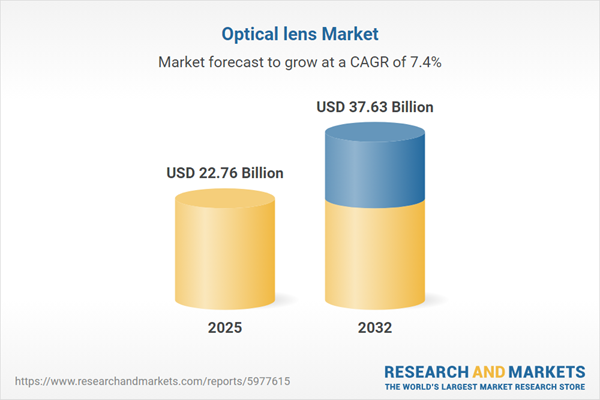Speak directly to the analyst to clarify any post sales queries you may have.
The optical lens market is advancing due to rapid technology enhancements and shifting regulatory requirements. For senior leaders, adapting to trends in healthcare, imaging, and industrial manufacturing is essential to maintain operational agility and seize growth opportunities in this evolving sector.
Market Snapshot: Optical Lens Market Size and Growth
The global optical lens market reached USD 21.21 billion in 2024, with expectations to climb to USD 22.76 billion by 2025, representing a CAGR of 7.42%. This trajectory is supported by increasing needs for high-performance vision solutions and the ongoing adoption of advanced lens technologies across sectors. Regions investing in healthcare and technology, along with continuous innovation in lens materials and coatings, are broadening the industry's scope and attracting investment from businesses seeking scalable solutions and extended commercial reach.
Scope & Segmentation of the Optical Lens Industry
- Lens Types: Includes bifocal, photochromic, progressive, single-vision, and trifocal; these options address diverse clinical requirements, workplace demands, and user lifestyles in both professional and consumer markets.
- Material Types: Glass, high-index, plastic, polycarbonate, and Trivex materials provide varying durability, clarity, and weight, allowing product selection to align with technical and consumer needs across key use cases.
- Coating Types: Anti-reflective, blue-light filtering, hydrophobic, scratch-resistant, and UV-protection coatings extend lens durability, comfort, and safety, particularly useful in demanding medical or industrial environments.
- End User Categories: Solutions cater to individuals with astigmatism, hyperopia, myopia, presbyopia, and those seeking enhanced comfort, aesthetics, or technical features tailored for specific sectors.
- Distribution Channels: Divided among e-commerce platforms, brick-and-mortar retail, clinics, and specialized eye care centers, offering flexible procurement options suitable for organizations of any size.
- Price Ranges: Economy, mid-range, premium, and ultra-premium products address various budgets and performance needs in different markets globally.
- Applications: The optical lens sector supports medical diagnostics, professional photography, and industrial instrumentation, each demanding unique standards for optical accuracy, safety, and compliance.
- Key Regions: Americas, Europe, Middle East and Africa, and Asia-Pacific, with each region driven by distinctive market forces, preferences, and regulations shaping product offerings and business models.
- Leading Companies: Major players such as EssilorLuxottica S.A., Carl Zeiss AG, HOYA Corporation, Nikon Corporation, Seiko Optical Products Co., Ltd., Rodenstock GmbH, Shamir Optical Industry Ltd., BBGR S.A., Transitions Optical, Inc., and Younger Optics, Inc. set benchmarks for innovation and secure wide market coverage leveraging scale in production and distribution.
Key Takeaways for Senior Decision-Makers
- Specialty and high-index materials provide a clear path to differentiated products, fueling growth in healthcare and technical manufacturing applications.
- Digital measurement and precision fitting empower organizations to deliver tailored solutions, advancing both patient care and business efficiency.
- Prioritizing sustainable materials and up-to-date coatings aligns procurement with environmental and regulatory developments.
- Artificial intelligence in lens customization and customer engagement improves accuracy and elevates the scalability of service delivery across the value chain.
- Partnering with health-technology specialists accelerates development cycles and enhances compliance in multinational operations.
- Regional supply chain strategies and agile sourcing help protect competitiveness and reinforce resilience amid fluctuating global market conditions.
Tariff Impact: Navigating Trade and Supply Chain Dynamics
Recent U.S. tariff policy revisions have led optical lens producers to reassess their global sourcing arrangements. In response, many companies are increasing domestic production capabilities, diversifying suppliers, and embedding advanced automation within manufacturing plants. These steps are designed to stabilize logistics, protect product quality, and secure market share despite ongoing trade uncertainties and evolving regulations.
Methodology & Data Sources
This report draws upon interviews with optical industry leaders, direct input from end users, regulatory document analyses, and proprietary datasets. By blending qualitative and quantitative methods, the findings enable focused strategic recommendations, greater operational insight, and heightened risk awareness for decision-makers.
Why This Report Matters
- Presents a comprehensive analysis of technological, sector, and commercial trends guiding the optical lens industry.
- Equips senior leadership to anticipate regulatory change, optimize technology integration, and advance supply chain effectiveness.
- Supports decision-making for investments and partnerships, enabling organizations to innovate and maintain business continuity in a dynamic market.
Conclusion: Charting a Path Forward in Optical Lenses
In the optical lens industry, adaptability and proactive strategy lay the groundwork for sustained advancement. Prepared organizations can capture new opportunities and navigate market evolution confidently as sector priorities and innovations progress.
Additional Product Information:
- Purchase of this report includes 1 year online access with quarterly updates.
- This report can be updated on request. Please contact our Customer Experience team using the Ask a Question widget on our website.
Table of Contents
3. Executive Summary
4. Market Overview
7. Cumulative Impact of Artificial Intelligence 2025
Companies Mentioned
The companies profiled in this Optical lens market report include:- EssilorLuxottica S.A.
- Carl Zeiss AG
- HOYA Corporation
- Nikon Corporation
- Seiko Optical Products Co., Ltd.
- Rodenstock GmbH
- Shamir Optical Industry Ltd.
- BBGR S.A.
- Transitions Optical, Inc.
- Younger Optics, Inc.
Table Information
| Report Attribute | Details |
|---|---|
| No. of Pages | 197 |
| Published | November 2025 |
| Forecast Period | 2025 - 2032 |
| Estimated Market Value ( USD | $ 22.76 Billion |
| Forecasted Market Value ( USD | $ 37.63 Billion |
| Compound Annual Growth Rate | 7.4% |
| Regions Covered | Global |
| No. of Companies Mentioned | 11 |









